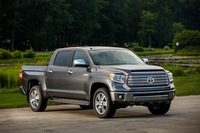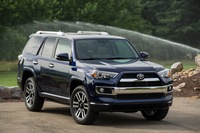2014 Toyota Tundra and 2014 Toyota 4Runner Updates By Steve Purdy
TOYOTA TUNDRA AND 4RUNNER UPDATES
A Smokey Mountain Drive
By Steve Purdy
TheAutoChannel.com
Michigan Bureau
We spent a few days at Blackberry Farm in verdant east Tennessee last week with the Toyota folks reviewing the updated versions of the Tundra pickup and the 4Runner SUV. Both have received some needed upgrades but neither experience substantial changes. The Foothills Parkway and the roads leading to the famous Dragon Tail twisty two-lane provided a good place to test out the freshened trucks.
2014 TOYOTA 4RUNNER
 |
The “new” 4Runner gets primarily cosmetic upgrades inside along with more premium audio, cooler gauges, in-glass antenna (replacing the old-fashioned mast), nicer materials and sleeker look overall.
The exterior, similarly, gets modernized and emboldened with more aggressive details, squinty headlights, crisper lines, color keyed bumpers, new front and rear fascia. Unless you know the model and look closely you’ll probably not be stricken by its new looks but it is a significant step forward in this writer’s humble view.
Beneath the skin little has changed. 4Runner still comes in 4X2, part-time 4X4 and full-time, multi-mode 4X4 configurations. It continues to be powered exclusively by the same trusty 4.0-liter V-6 making 278 horsepower and 278 pound-feet of torque mated to a sturdy ECT-i 5-speed automatic transmission. The EPA rates this combination at 17-mpg in the city and 22 on the highway.
 |
We’ll see the new 4Runner at dealers in early September.
Unfortunately, we ran out of time at the recent launch event so I cannot provide driving impressions yet. That will have to wait until I get my hands on one for a full review.
2014 TOYOTA TUNDRA
 |
Tundra gives little attention to anything under the skin but the Toyota marketing folks believe there is little there that needs attention. Their niche among manly pickups can be characterized as the “urban cowboy,” that is, more show than go. Basic work capabilities must be competitive, but that is not necessarily the focus.
We first saw the new truck in its pre-production form at the Chicago Auto Show last winter. Styling and design, both outside and in, get substantial upgrades. It is now more truck-like in style and more upscale in design and appearance.
Outside the edges are more defined, headlight and taillight bezels modernized, tailgate redesigned and deeply embossed with the Tundra name. The tailgate even has a minimal integrated wing. The more stylish grilles and front fascia varies with the different models and trim and the new 3-piece front and rear bumpers make it both more attractive and cheaper to fix after those minimal bumps a scrapes.
 |
We’re told by Toyota officials that their deep and extensive conversations with customers convinced them they need to do nothing more with the powertrains currently. The three engine offerings – one V-6 and 2 V-8s – remain unchanged from last year’s model. The 4.0-liter V-6 comes only in the base, two-wheel drive, plain-Jane truck and constitutes a small percentage of sales. The next step up is a 4.6-liter V-8 making 310 horsepower and 327 pound-feet of torque. That engine is mated to a six-speed automatic transmission and came on line in 2010 so is up to date with variable valve timing and other technologies. It generates nice throaty noises when we put our foot in it, by the way. The EPA rates that engine/transmission combination at 15 mpg combined city and highway. That is less than the competition at Ford, Ram and GM, who are adding direct injection, turbo charging and other advanced engine technologies to gain a few more mpg. Toyota thinks the extra development costs were not worth it because the customer doesn’t put that much value on that mileage proposition and they claim that real world mileage for the others is in the 15-mpg range anyway. I think the others might dispute that.
The other engine option is a 5.7-liter V-8 making 381 horsepower and 401 pound-feet or torque, also with a six-speed automatic.
All Tundra and mid-size Tacoma pickups are assembled in the Texas plant. Prices for Tundra will range from $25,920 for the base model to $47,020 for a Platinum 1794 version.
We were able to get just enough seat time to get a good sense of the new Tundra around the foothills of the Smokey Mountains, from the little town of Townsend up the twisty paved road into Cades Cove then down the side of the mountain on a gravel stretch and finally along the Foothills Parkway. Anyone familiar with that part of the country will attest to that magnificent scenery and those great roads.
Initial impressions are of a big, smooth and quiet truck with a good degree of sophistication. That wide expanse of hood tends to be a bit disconcerting on narrow roads at first but the suspension, steering and overall handling make up for it and we acclimate easily. I was surprised at how tight was the turning radius after we missed a route instruction. At our lunch stop we had an opportunity to pull a heavily laden trailer to experience the truck under load. With a towing capacity around 10,000 pounds we pulled 8,500 and it felt stable and strong. The big V-8 makes 75% of its torque as low as 2,500 rpm. Not bad.
The Tundra will continue to compete in fourth place in this light truck market, but the Japanese connection will continue to cause consternation among traditionalist. The design and engineering were done primarily in the U.S. and it has more North American content than the others, they insist. Tundra’s marketing is primarily aimed at an urban cowboy and Hispanics rather than the mainstream working fella but the truck’s capabilities stack up well.
“Will we ever see a diesel Tundra or a heavy duty version?” asked one of our colleagues.
“We’re looking at that,” was the minimally evasive answer.
We’ll do a more thorough review once we’ve had the opportunity to live with it for a while.
© Steve Purdy, Shunpiker Productions, All Rights Reserved




